Transforming your home to look like it was designed by a professional doesn’t have to be difficult. There are countless tips and tricks you can use to achieve a designer look with ease. We’ve gathered insights from several top designers who have shared their straightforward and effective home decor ideas to infuse new energy into your space. In this article, we’ll offer practical decorating tips to refresh every room in your home, all while staying within your budget.
1. First Impressions Matter: Setting the Tone at Your Front Door
To ensure your home makes a memorable first impression, consider painting your front door in a vibrant, glossy color. According to Lara Allen-Brett, a stager from New Jersey, red holds symbolic significance across many cultures—it historically signaled “welcome” to travelers and represented safety on churches.
San Francisco-based stager Christopher Breining suggests that orange and yellow are also becoming popular choices. These colors evoke feelings of joy and warmth, further enhancing the welcoming feel of your entryway.
If you have an outdated screen door, it’s time for an upgrade. Consider replacing it with a modern storm door featuring full-length glass panels that can be swapped with screens as needed. This simple change can modernize your entry while improving functionality and aesthetic appeal.


2. Creating a Serene Atmosphere: Light and Neutral Wall Paint Ideas
Changing the paint color in a room can dramatically transform its atmosphere. Opting for neutral shades like beige or gray, especially on the first floor, helps maintain a cohesive flow throughout your home, as recommended by Christopher Breining. This approach minimizes abrupt transitions between spaces and provides flexibility in decorating with various accessories.
For adjoining small rooms, Lara Allen-Brett advises painting them in the same neutral color to create a sense of spaciousness. You can achieve subtle variation by selecting shades from the same paint strip, adjusting up or down a shade or two between rooms.
Updating paint colors is a cost-effective way to refresh a room without breaking the bank. By coordinating the new color with existing decor, you can avoid the need for additional accessory purchases. Alternatively, painting an accent wall can introduce contrast and visual interest without overwhelming the space.

3. Sofa and Chairs: Ensure Your Chairs and Sofa Are in Sync
Creating a warm and inviting living space where people naturally gather involves thoughtful furniture arrangement. According to Michelle Lynne, a stager from Dallas, setting up a conversation area in a U-shape or H-shape configuration is ideal. In a U-shape, placing a sofa and two chairs facing each other around a coffee table fosters intimate conversations. Alternatively, an H-shape arrangement with a sofa opposite two chairs and a central coffee table also promotes connection and interaction.
Lynne advises against the common mistake of pushing all furniture against the walls to create more space. Contrary to popular belief, floating furniture away from walls can actually make a room feel larger. This arrangement not only enhances the sense of space but also encourages a cozy and inviting atmosphere where people feel comfortable and connected.

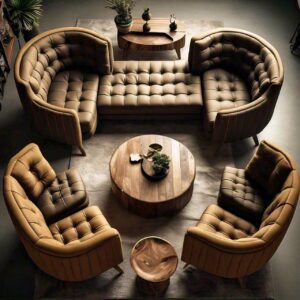
4. Open Up to Sunshine: Enhancing Your Home’s Atmosphere
When it comes to dressing your windows, Michelle Lynne suggests that leaving them bare is better than using old-fashioned, heavy drapes. It’s important to find a balance between practicality and style. She recommends using sheer curtains along with full-length panels to create a classy look that allows natural light in while maintaining privacy.
If your room gets a lot of sunlight, choose light-colored fabrics that won’t fade quickly. Fabrics like cotton, linen, or silk blends are great choices because they hang nicely and add a touch of elegance to your space.
If you’re looking to update your window decor without spending a lot, consider options like simple curtains, roller shades, or vertical blinds. These can enhance the look of your room without breaking the bank. Alternatively, leaving your windows bare can make the room feel more spacious and airier by letting in natural light.
Whether you opt for curtains or leave your windows uncovered, the key is to ensure that your choice complements both the function and style of your room, creating a warm and inviting atmosphere.
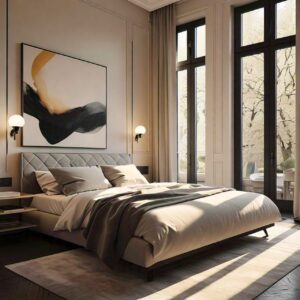
5. Reflect Your Space: Tips for Hanging Mirrors in Every Room
According to Christopher Breining, mirrors have the ability to enhance the brightness of a space by reflecting light throughout the room. However, their placement is crucial for achieving this effect effectively.
To maximize the light-boosting benefits of mirrors, place them on walls that are perpendicular to windows rather than directly opposite them. Placing a mirror directly across from a window can inadvertently bounce light back out, diminishing its impact within the room.
Careful positioning of mirrors ensures that they effectively amplify natural light, contributing to a brighter and more inviting atmosphere in your living spaces.
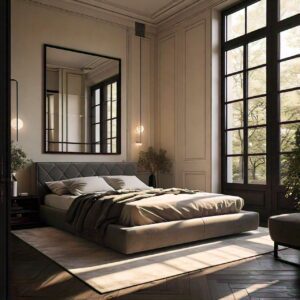
6. Creating Balance: Scaling Artwork for Your Wall
Christopher Breining advises against hanging small art pieces too high on the wall, which can look disproportionate and awkward. Ideally, the center of a picture should be at eye level, taking into consideration the average height of people who will view it.
Scale is crucial when decorating walls. For a large wall space, opt for a single oversized artwork or arrange smaller pieces in a gallery-style display. When grouping smaller artworks, ensure they are not spaced too far apart—typically, maintaining a distance of 2 to 4 inches between items creates a balanced and visually appealing arrangement.
By carefully considering both height and scale, you can create a well-proportioned and aesthetically pleasing display that enhances the overall look and feel of your space.
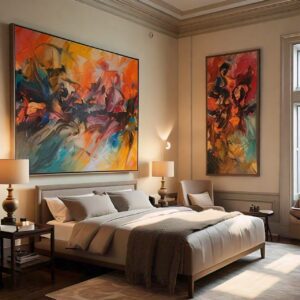
7. Lighting Layers: Creating Depth and Warmth in Your Home
Lighting is crucial in our homes, influencing the atmosphere and mood of each room. To create a well-rounded lighting scheme, every room should incorporate three types of lighting:
1. Accent Lighting: This type of lighting is decorative and is used to highlight specific features in your home, such as artwork or architectural details.
2. Ambient Lighting: Ambient lighting provides overall illumination for a room and is typically provided by ceiling fixtures like chandeliers or recessed lights.
3. Task Lighting: Task lighting is focused on areas where specific activities are performed, such as over a kitchen island for cooking or in a reading nook for reading.
In a living room, it’s recommended to have at least 3 watts (or 42 lumens) per square foot to ensure adequate brightness. Christopher Breining suggests a visual trick using up lights, such as canister up lights or torchieres placed in corners. These lights cast a soft glow on the ceiling, creating an illusion of more space and adding depth to the room’s ambiance.
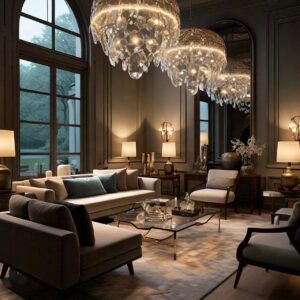
8. Enhance Your Décor: The Importance of Anchoring Rugs Under Furn
When it comes to area rugs, placement and sizing are crucial. According to Christopher Breining, in a living room setting, the rug should define the seating area. Ideally, all four legs of the sofa and chairs in a furniture grouping should fit on the rug. At minimum, the front legs of the sofa and chairs should rest on it to anchor the space.
Even in living rooms with modest dimensions, a larger rug, such as an 8-by-10-foot or 9-by-12-foot, is typically recommended to properly accommodate the seating arrangement. Opting for a rug that is too small can disrupt the visual balance of the room, throwing off its proportions.
By ensuring the right size and placement of the rug, you can enhance the overall look and functionality of your living room, creating a cohesive and welcoming environment for gatherings and relaxation.
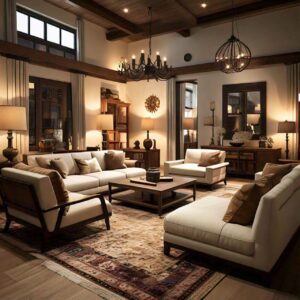
9. From Dated to Elevated: Updating Your Home’s Finishes
If you have dated fixtures in your home, consider using spray paint and affordable refinishing kits to reinvent them. For example, a 1980s brass chandelier can take on a new look with a coat of hammered-bronze or satin-nickel spray paint, giving it a modern appearance.
Old kitchen cabinets can be refreshed with a fresh coat of white paint and updated hardware. For outdated Formica countertops, products like Rust-Oleum Countertop Transformations offer DIY solutions that mimic the look of stone, revitalizing even the oldest surfaces.
To complete the makeover, replace cracked or mismatched switch plates and outlet covers with new, matching ones. This simple update can significantly enhance the overall look of your space. By implementing these budget-friendly strategies, you can transform dated fixtures into stylish accents that breathe new life into your home.
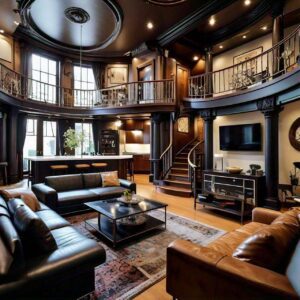
The Conclusion:
Transforming your space and enhancing its flow can be a creative endeavor. Consider brightening your front door with a bold, punchy color to make a striking first impression. Hanging sheer curtains on windows allows natural sunlight to filter through, adding warmth and brightness to your rooms. For a cozy and inviting living area, arrange furniture in a U-shape or H-shape to promote conversation and connection.
You can enjoy decorating your home affordably by applying a fresh coat of paint to walls, which can instantly update and refresh the entire room. Dressing up windows with stylish curtains or blinds adds texture and personality. Swapping out an old area rug for a new one can redefine the space, adding comfort and visual interest.
By incorporating these simple and budget-friendly ideas, you can flex your creative muscles to transform your home into a welcoming and stylish retreat.
FAQ About DIY Home Decorating
How can I make my room look bigger?
To create the illusion of more space, start by painting your walls in lighter shades that open up the room and make it feel airy. Consider removing heavy curtains and rugs to reduce visual clutter and allow more light to flow through. Opt for furniture that fits the scale of your room, avoiding oversized pieces that can overwhelm the space. Additionally, strategically placing mirrors to reflect light can enhance the perceived size of your room.
What are some common decorating mistakes to avoid?
Avoid common decorating blunders to ensure a cohesive and well-designed space. These include insufficient lighting sources, choosing furniture that doesn’t suit the room’s dimensions, neglecting to declutter before redecorating, and using rugs that are too small for the area. Addressing these mistakes helps maintain balance and functionality in your decor.
How can I decorate on a budget?
Decorating on a budget requires creativity and smart choices. Start by giving your room a fresh look with a coat of paint in a new color palette. Upgrade your lighting fixtures with budget-friendly options to improve ambiance and functionality. Introduce inexpensive accessories like throw pillows and artwork to personalize your space. Consider DIY projects such as refinishing furniture or repurposing items to achieve a custom look without spending a lot. These approaches allow you to enhance your home’s style and comfort affordably.
About the Author

-
Welcome to A HomedesignMag! I'm Nancy, a content writer and blog post creator. I share my experience with different homedesign tools and techniques on the blog!
contact us at:
Latest entries
 UncategorizedOctober 15, 2024Timeless Beauty of Mahogany
UncategorizedOctober 15, 2024Timeless Beauty of Mahogany OutdoorsOctober 13, 2024Patio Perfection: 9 Awe-Inspiring Roof Extension Ideas to Add Charm
OutdoorsOctober 13, 2024Patio Perfection: 9 Awe-Inspiring Roof Extension Ideas to Add Charm WindowsAugust 13, 2024Elevating Interiors with Kirsch Sliding Door Blinds
WindowsAugust 13, 2024Elevating Interiors with Kirsch Sliding Door Blinds BathroomAugust 11, 2024Designing Showers with Mosaic Tiles
BathroomAugust 11, 2024Designing Showers with Mosaic Tiles




